COMPONENTS OF THE SYSTEMATIC APPROACH
Skilled performance improvement professionals will likely cite a specific model that they developed or use to guide them through a Systematic Approach to a particular performance improvement opportunity. Established experts like Harold Stolovitch, Don Tosti, Geary Rummler, Judith Hale, and Margo Murray have their individual views of what constitutes a Systematic Approach to performance improvement. However, all the models are reproducible and have these elements in common: diagnosis, prescription, and evaluation. A representative example is the Performance Consulting Systems Approach model shown in Table 6.2 (ISPI, 2004). The approach shown is not linear, even though it appears so in this model.
TABLE 6.2. Performance Consulting Systems Approach.
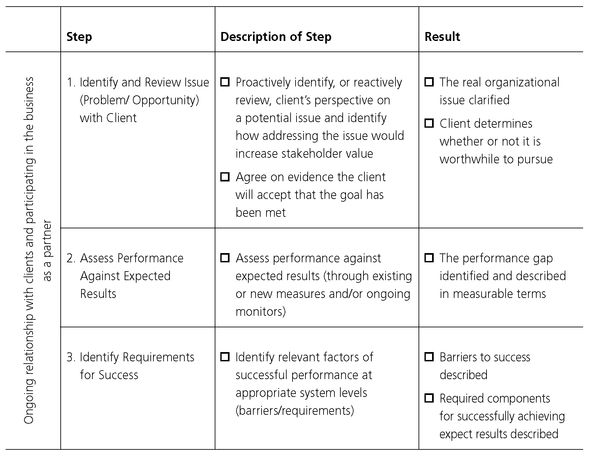
Source: ©2004 International Society for Performance Improvement. Used with permission.
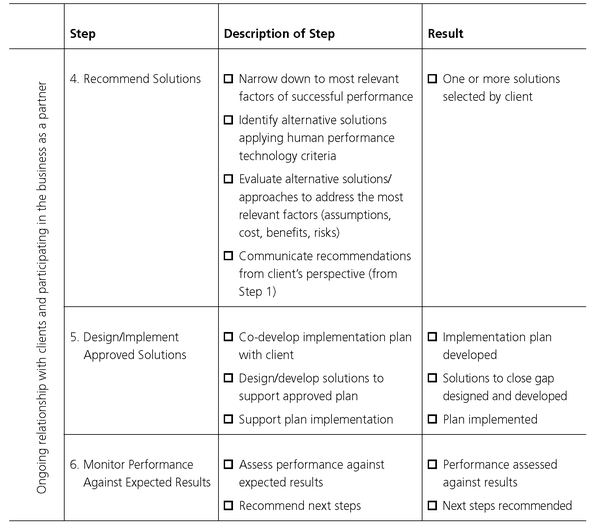
For discussion purposes, consider that the Systematic Approach is composed of the six core elements presented in Table 6.2, plus one more—Evaluation. Let’s use them to explore the steps in the process and the types of results a skilled performance consultant is likely to generate. Remember that what follows in the Systematic Approach in Table 6.3 is presented step-by-step. However, in reality, the nature of organizations, people, and information cause overlapping steps, backtracking, and skipping ahead. Ultimately, all the steps in the Systematic Approach will be covered, and the results described here will be achieved. Note that the applicable role/responsibility for each step in the process is described to emphasize the agility required to successfully bring a performance improvement project from conception to full integration in the organization.
TABLE 6.3. Systematic Approach.
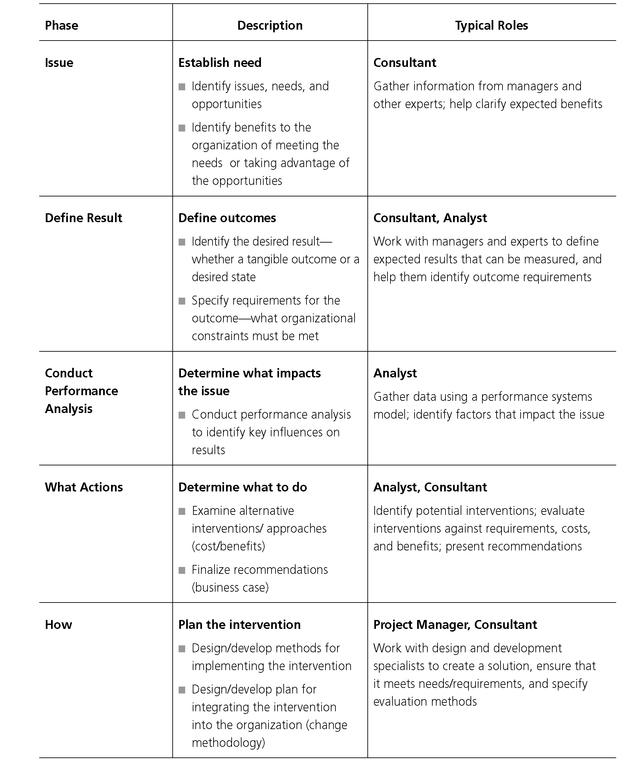
Source: ©2004 International Society for Performance Improvement. Used with permission.
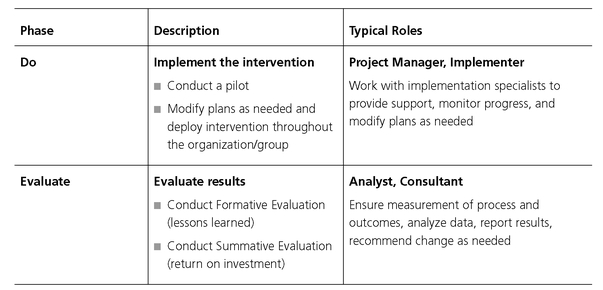
Identify Issue
Most performance improvement opportunities are identified because someone in management specifies a need, problem, or opportunity and looks for a solution. For the issue to have credence, the manager must be able to articulate how addressing it will benefit the organization. Frequently, this is described as the familiar “business case,” which many organizations require be documented before any resources are allocated.
Usually, the issue is broader and/or deeper than initially presented, and it falls to the performance consultant to investigate thoroughly to clarify all its parts. Managers, customers, and other stakeholders can help expand the initial business case and elucidate the benefits they anticipate from resolution of the issue. Critical elements of a business case are shown in Table 6.4. These generally include:
• Benefits of the initiative described in terms of the current and desired states, the resulting gap, and the impact of closing that gap as reflected in revenue, costs, and other affected elements in section A
• Cost of the initiative to both the provider and recipient broken down by the steps in the Systematic Approach listed in section B
• Projections of potential returns from the success of the initiative, from section C
• Decisions and next steps from section D
TABLE 6.4. Business Case.

Source: ©2004 Geary Rummler and the Performance Design Lab. Used with permission.
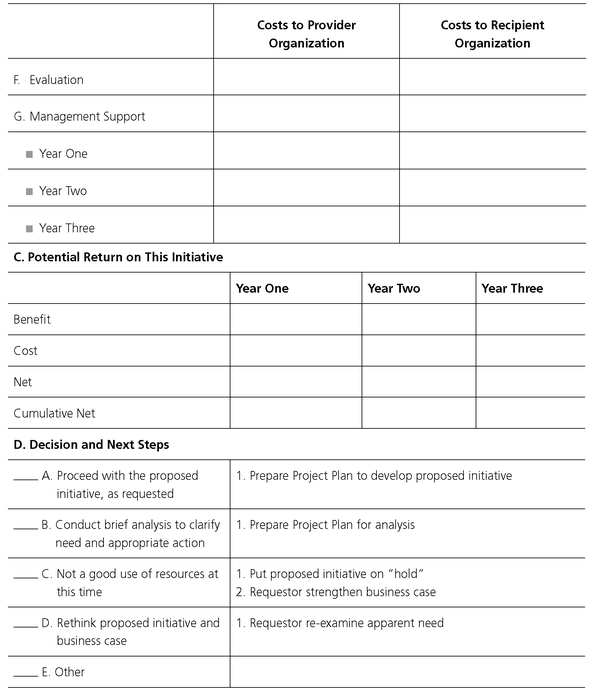
The performance improvement specialist works in a consulting role to produce these outcomes: a clear issue statement, or description of the current state, supported by a strong business case and clearly articulated expected benefits from successful resolution of the issue. The initiating manager or designee becomes the client for the project.
Project Management for Issue Identification—Initiating. With the business case developed, we’re ready to get management’s sign-off and begin. In project management terms, this is often referred to as “initiating.” This is where the requisite information is provided to the client and the project is authorized (Greer, 1996, p. 13). The consultant is likely to be involved in budget discussions, negotiations, presentations, and other preliminary communications to launch the project.
It is a good practice, at this stage, to clarify who the ultimate client is—that is the person who signs off on the completed project and who funds the work—and what your expected contact with the client will be during the project. It helps to be clear about the value of the project to the client and to the organization. This is the time to identify the executive sponsor and let this person know that the project has been launched. In Chapter 4, The Workplace: Organization Level, you’ll find a complete discussion about executive sponsors or champions. Ask your client to name the various subject matter experts (SMEs) who will review the project deliverables.
Define Result
This is a further refinement of issue identification. It calls for the performance improvement specialist to partner with managers and appropriate stakeholders to define the desired result in terms of a tangible outcome or a desired state. The work done here includes specifying requirements for the anticipated outcome and identifying the organizational requirements that must be met. Ultimately, the expected results must be measurable.
With organizations facing continued fiscal constraints in our volatile economy, leaders are carefully examining every proposal that comes before them to ensure that, if adopted, it will result in measurable gains in such areas as revenue, profits, market share, community impact, or brand recognition. A carefully constructed business case, using the elements called out earlier, will point to the significant metrics to track.
The results are identified outcome requirements, or the standards the solution must meet for the project to go forward. A useful guide to establishing criteria for each result is the familiar S.M.A.R.T. goals model (SMART Goals, 2008). A S.M.A.R.T. goal is:
• Specific. Rather than a general goal such as, “Reduce employee turnover,” try “Use the five company employee retention strategies to reduce turnover.”
• Measurable. Set criteria to measure progress toward the goal. Describe how much, how many, and how you will know you have accomplished your goal. “Use the five company employee retention strategies to reduce turnover by 10 percent by January 31.”
• Attainable. A successful goal is one that is within reach. If it is a very ambitious goal such as, “Use the five company employee retention strategies to reduce employee turnover by 50 percent,” breaking it down into annual or even quarterly goals will make it easier to visualize success and increase the chances of achieving it.
• Realistic. A goal is probably realistic if those behind it believe that it can be accomplished. Has a similar goal been reached in the past? What conditions must exist to accomplish this goal? “Use the five company employee retention strategies to reduce employee turnover by 10 percent each year for the next five years, and ensure full management participation.”
• Timely. A goal should be time boxed so that it has an anchor and creates a sense of urgency. Set a date and include it in the goal statement. “Follow the five company employee retention strategies to reduce employee turnover by 10 percent each year for the next three years, and ensure full participation by requiring end-of-month updates from all managers as part of their regular progress reports.”
Project Management for Defining Results—Planning. As we’ve seen, the most effective way to begin improving performance is to start at the end. Sometimes we get lucky, and the client can clearly and accurately specify the results of a successful project. From there, it is a brief excursion to identifying the measurements that will show the degree of the project’s success. When we know the destination, we can plan the journey.
Here, we are in the Planning stage of project management where we develop the project plan, from analysis forward as far as we can anticipate, and identify the resources we need. These include SMEs, managers, exemplary performers, performance improvement designers and developers, and perhaps others who will join the project team as we move forward. It is a good idea to source the documents that will help with the analysis at this stage and to identify sites for observation and data gathering. Identify the deliverables that result from each step in the plan.
Some organizations follow a standardized project management process and have planning tools and templates available. To create your own, there are a number of helpful publications suited to the types of projects performance improvement professionals manage. We like Michael Greer’s The Project Manager’s Partner (Greer, 1996) and Timm Esque’s No Surprises Project Management (Esque, 1999). The latter lends itself to projects at the Workplace/Organization level.
Conduct Performance Analysis
This step looks deceptively simple in the Systematic Approach table (Table 6.3). In reality, it is usually the most layered activity in the Performance Improvement Process. Performance Analysis involves:
• Planning the scope of a diagnostic investigation of the performance improvement problem or opportunity
• Selecting data gathering methods, identifying stakeholders to interview, and scheduling observations to see first-hand the work, workers, and workplace where the performance improvement issue is present
• Determining when, how, and to whom to report Analysis findings and recommendations
In the analyst role, the performance improvement specialist looks specifically at the gap between the current and desired states of the performance issue and generates probable causes or drivers. Performance issues can become apparent at any of the organizational levels—in the processes, with particular workers or work groups, or across the organization. During Analysis, it is important to determine whether the drivers are resident at a higher level so that the origins of the issue are identified and addressed.
The wise performance consultant also relies on a performance systems model, such as the Total Performance System (Brethower, 1982) to ensure that all areas of the organization that are or could be touched by the performance issue are identified. We introduce the Total Performance System (TPS) in Chapter 2, The Worker: Individual/Team Level. We like this model because it is scalable and suits performance improvement work at any of the three organizational levels. Figure 6.1 is another rendition of the TPS.
FIGURE 6.1. Total Performance System.

Expect Surprises. Performance Analysis is rather like home repair—it is rarely as simple as we assume when we begin removing the first layer of wallpaper. It helps to be prepared for surprises such as the SME who is suddenly unavailable or uncovering evidence of issues more complicated than anticipated. In such situations, remember that when the findings start to repeat, your data gathering is probably complete.
One of us worked with a large international technology company that makes products for the pharmaceutical industry. A new product was to be introduced and the sales manager wanted to know what information the salespeople needed to sell it and how best to ready them for the launch. Two of the promised analysis resources were to be sales goals and sales production information from each geographical location. These never materialized. After poking and prodding unsuccessfully, the consultant negotiated for additional analysis funding, increased the scope of her interviews, and gathered the missing information anecdotally. It was sufficiently accurate to complete the analysis.
Frequently, an analysis turns up information already known to the client, but the performance consultant provides the added value of confirming it and performs the important tasks of organizing it for the client.
Making Recommendations. When an analysis results in a long list of recommendations, be nice to your client, and prioritize them, placing those with the most impact first. You will probably find that the first two or three have an obvious priority order, that one or two belong at the very end of the list, and that the remaining recommendations carry equal weight and can appear anywhere in-between.
For the technology project described above, the consultant made eleven recommendations. The client agreed that the first three of these were critical and then chose a few more from the balance of the list to be acted upon.
Sometimes, a consultant contracts and launches a performance improvement project only to learn that certain areas are off limits. This can have quite an impact on the project, particularly if the analysis data points to the forbidden area as a possible driver/cause of the performance issues.
Two consultants were working with a large public health organization to help them with their new hire orientation program. Early in the analysis phase, the senior management team told the consultants they could not consider the structure of the organization as an influence on employee recruitment or retention, nor could they make recommendations about how the business should be run. Since it appeared likely that the design of the business did contribute to many of the internal issues the organization faced, the consultants had to work around the business design when making their recommendations.
Presenting Analysis Data. Performance Analysis results in a detailed description of the performance issue and the drivers or causes responsible. Quite possibly the analysis will raise several related concerns, and it may identify a broader opportunity for improvement than originally described. Chapter 4, The Workplace: Organization Level, presents guidance for organizing analysis data and presenting it to senior leaders. It is a good practice to apply the same rigor to all presentations of analysis data to clients at any level of the organization. Here are some reporting techniques for presenting analysis data to clients at any organizational level, both in written reports and in visual-driven presentations. Choose one or more that suit your project:
• Place an executive summary at the beginning of your findings report and lead with information that confirms what the client asked for or assumed you would discover
• Use the elements of the project’s business case to organize and present the findings
• Follow the format of the investigative model you used in your analysis to give continuity to the report
• Present the findings in the body of the report with a few representative statements from interviewees to give key concerns more impact and ground them in reality
• Attach the logistical information in an appendix—things like the number of people interviewed, observations made, locations visited, specific questions asked
Project Management for Conducting Performance Analysis—Executing. In project management terms, we are now in the Executing phase. A detailed analysis blueprint with action items, dates, resources, sites, and specific activities laid out will help immeasurably and allow you to accurately track multiple streams of information. As circumstances change—the key subject-matter expert you spent weeks trying to schedule has suddenly gone on leave—your detailed plan will help you find other information sources.
Consider organizing your analysis blueprint with one eye on how you will present your findings to your client. The more orderly your analysis plan documents, the easier it is to pull together the results and draw conclusions that flow logically from the information you have compiled. Take a close look at the models and tools you are using in your analysis to see if their layout can guide your analysis report.
Actions to Take
This is where the performance consultant determines what can be done to resolve the performance issue(s). In many such situations, the possible solution may be composed of several actions that are best addressed in sequence. A colleague refers to this as the “basket of solutions” (In conversation with Lane, 2008). In other cases, there are clear-cut choices the client must make about what to do. Certainly there are time and budget considerations that may eliminate some possible solutions. And critically, there are cultural norms that must be factored in so that the chosen solution will be implemented and accepted.
Consider Cultural Norms. Sometimes, significant cultural norms don’t make themselves known until solution development is well underway. One of us did a project with a public relations department in a large organization. The manager wanted a way to quickly orient his new hires, mostly transfers from within the company, to their new roles in his department and in their communities so that they could be productive right away. The consultant designed a do-it-yourself orientation program that the new hire drove with the help of a mentor and the local administrative assistant. There were written guides for each role. All the materials were housed online for easy retrieval. A few weeks after implementation, the client phoned to say that the administrative assistants had requested a class on the program because they were uncomfortable without one. “We always have a class,” they said, stating a company norm. If your performance improvement solution breaches one of these, you must either address it or find a different solution.
Partnering with the client at this stage to examine all possible solutions provides a reality check that can save time and effort. The more invested your client is in the Actions to Take, the better the chances of a successful implementation and resolution of the issue(s).
This step results in recommended solutions that meet requirements, budget, and the expected benefits identified in the business case at the beginning of this process. At the conclusion, the client selects the solutions(s) and determines how to proceed.
Project Management for Actions to Take—Executing and Controlling. Since the project is still in process during this stage of the Systematic Approach, we continue in the Execution phase of project management. During Execution, consultants typically encounter challenges as they move the project forward. This is called Controlling because aspects of the project can shift or cause difficulties during Execution and require plan changes. For example, your analysis may have uncovered some issues to investigate further. These may affect several project plan components and can ultimately change the schedule and the project’s scope. In such circumstances, it is helpful to consult checklists or other tools to help clarify what has occurred and how you might proceed (Greer, 1996, pp. 119-121).
How—Plan the Solution
With the solution selected, the work of designing and developing it begins. Considerations include:
• Establishing a project team to execute the solution
• Identifying how the solution’s success will be measured and evaluated
• Ensuring that the solution meets the needs and requirements specified at project inception
• Designing communications, materials, and related solution components
• Selecting a change management methodology for successful integration into the organization
• Deciding, with the client, who will own the completed project and be responsible for its continued maintenance
This step results in a complete package of plans and materials approved by the client that meet the original project requirements for performance improvement and that specify how the project will be evaluated.
Project Management for Planning the Solution—Closing. The performance consultant may be responsible for analysis only, so the project ends with solution recommendations. Or the project might end at this phase in the Systematic Approach with the delivery of all completed materials. In either case, the comparable project management phase is Closing and calls for the formal completion and shutting down of the project, with team members returning to their regular responsibilities and the project materials stored and maintained as planned at project inception. Closing includes the client’s formal sign-off on the project (Greer, 1996, pp. 125-127).
Do—Implement the Solution
There are a number of critical aspects to implementation that differentiate an initiative that is implemented but never fully integrated into the organization, from one that is carefully orchestrated to become part of its fiber. As project manager and implementer, the performance improvement professional has much to do, including:
• Planning the complete implementation
• Ensuring all involved segments of the organization are supportive and invested in the success of the project
• Determining how the implementation and its aftermath will be evaluated and monitored and by whom
• Piloting the implementation and making adjustments to the overall plan
• Setting specific goals for the ongoing life of the project
Working with implementation specialists and client representatives, the performance consultant establishes support mechanisms and monitoring processes for the project, and provides for any needed modifications to plans and materials.
Implementation is covered in greater detail in Chapter 6, Implementation: Weaving Performance into the Organization.
Project Management for Implementation—Closing. The performance improvement professional is uniquely qualified to design and support a project implementation that fully integrates it into the organization. We encourage you to do all you can to continue with projects through this critical step in the Systematic Approach rather than turning them back to your client. From a project management perspective, at the conclusion of implementation, you execute the Closing activities described earlier in Project Management for Planning the Solution.
Evaluate
In many HPT models, the evaluation step appears at the end. In the Systematic Approach, it is in this position because something has to be last. In reality, the seasoned performance consultant ensures that a well-designed and managed performance improvement project has evaluation built into every step. This will allow adjustments and modifications as needs arise, saving time and expense throughout the life of the project.
In the roles of analyst and consultant, the performance improvement professional plans to evaluate effectiveness and value at each step throughout the project.
Formative Evaluation. Performance Consultants conduct formative evaluations during solution design, development, and implementation to improve the effectiveness of the solution. This type of evaluation:
• Provides information about the solution while it is still under development and can be revised before additional investments are made
• Is performed on prototype material and solutions
• Checks progress
• Is conducted to determine the adoption or continuance of a solution and leads to a “go/no go” decision
The consultant uses formative evaluation techniques to identify lessons learned so that appropriate adjustments can be made for the balance of the project, providing performance feedback to the project team and the project’s client.
Summative Evaluation. Performance consultants perform summative evaluation after implementation, to determine whether the solution closed the gap and whether or not it was worth the investment. Summative evaluation provides feedback on the value of the project to the finance group, the customer, and other stakeholders.
Today, savvy organizations look at the return on investment (ROI) for performance improvement project implementations. Much as been written and studied about how best to track and calculate the ROI for training programs (Stolovitch & Maurice, 1998) and other performance improvement solutions.
In organizations where the balanced scorecard is used to evaluate results throughout the organization, it is quite possible to use it to evaluate a project after implementation because the balanced scorecard provides a direct link to the business results (Silber, 2008). As with all forms of evaluation, be sure the balanced scorecard elements are identified early in the project so they are in place when needed.
As a performance consultant, you want to find out which metrics your organization is tracking and which ones they particularly care about, such as those related to yearly targets and goals. Whether you are establishing the worth of taking on a project during the analysis phase or measuring the results at the end of implementation, you want to focus on metrics that the organization is currently trying to improve.
The four balanced scorecard categories identified by Kaplan and Norton (1996) are
• Financial perspective
• Return-on-capital-employed
• Customer perspective
• Customer Loyalty
• On-time delivery
• Internal - Business - Process Perspective
• Process quality
• Process cycle-time
• Learning and Growth Perspective
• Employee skills
We have found it useful to adapt these categories to meet clients’ individual requirements. Table 6.5 lists common metrics organizations use to track each of these categories. Consider the list as a menu from which to choose meaningful measures.
TABLE 6.5. Balanced Scorecard Metrics Menu.
Source: ©2007 International Society for Performance Improvement. Used with permission.


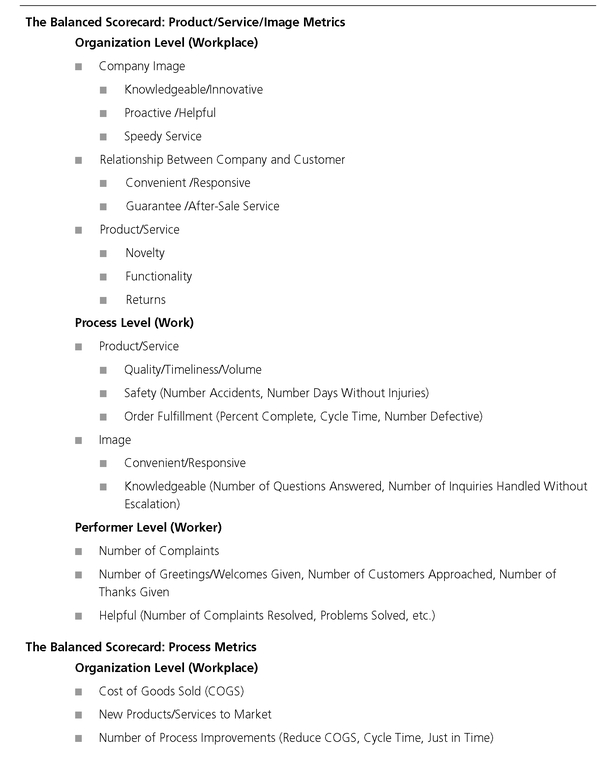
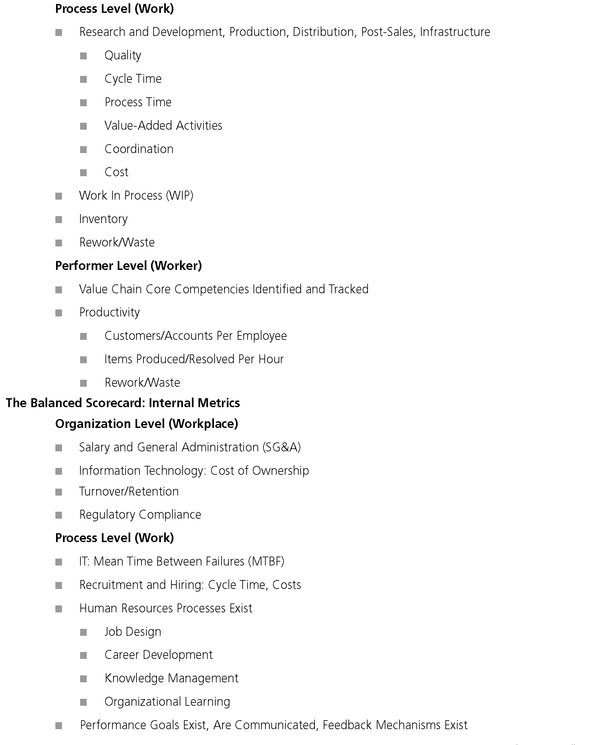

Guidelines for Success
Using project management skills and performance improvement tools and techniques to successfully navigate through the Systematic Approach is part art and part science. We share with you two lists of what to do and what not to do:
Ten Guidelines for Success as a Performance Consultant
1. Provide relevant information—know what you are talking about
2. Have the courage to speak up—believe that what you can contribute is of value
3. Make people feel comfortable—communicate with warmth and care
4. Trust what you hear (and verify it)—seek corroborating evidence
5. Learn the politics—make your client look good
6. Ask the difficult questions—make people stop to consider new information
7. Establish your credentials—ensure your clients know you are well-regarded outside their group or organization
8. Establish a presence—what is your signature and what are you known for?
9. Remain impartial and objective—form opinions without choosing sides
10. Stay focused—your goal is to improve performance; being liked is secondary
Adapted from Hale (1998), The Performance Consultant’s Fieldbook
Ten Mistakes to Avoid as a Performance Consultant
1. Forgetting to ask the question, “If this is the solution, then what is the problem?”
2. Assuming that a client who is difficult to reach and communicate with before the project begins will be more available and agreeable once the project is launched
3. Ignoring assumptions listed in your project proposal when you discover that they are not valid
4. Failing to inform your client as soon as an assigned resource becomes a problem
5. Neglecting to make your client look good
6. Pushing products on your client; instead, partner to solve problems or leverage opportunities
7. Beginning a project without a planned and orchestrated kick-off meeting, even if it is on the telephone
8. Taking on a project without including an analysis
9. Running off at the end of a project; be sure to debrief with your client and project team
10. Ignoring hidden agendas and politics
Adapted from performance consultants’ suggestions compiled by Miki Lane, 2000
..................Content has been hidden....................
You can't read the all page of ebook, please click here login for view all page.
